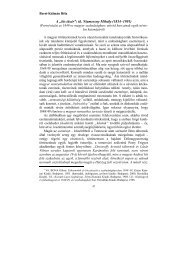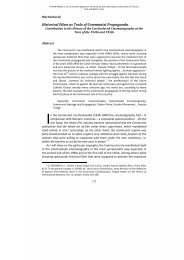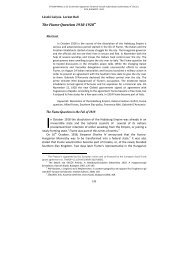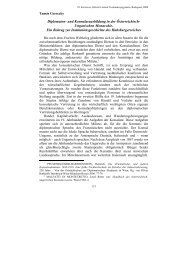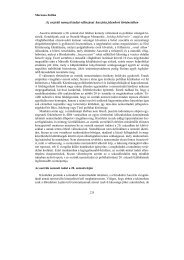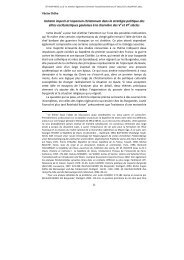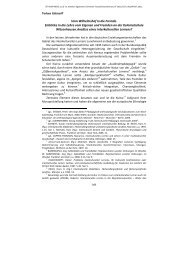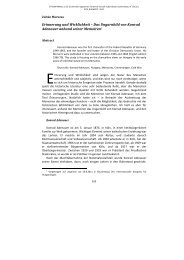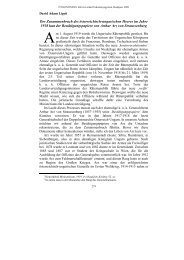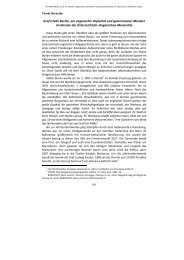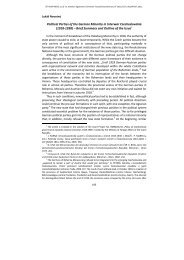The Molotov-Ribbentrop Pact - ELTE BTK Történelem Szakos Portál
The Molotov-Ribbentrop Pact - ELTE BTK Történelem Szakos Portál
The Molotov-Ribbentrop Pact - ELTE BTK Történelem Szakos Portál
You also want an ePaper? Increase the reach of your titles
YUMPU automatically turns print PDFs into web optimized ePapers that Google loves.
those of Déat, Pivert, Zoretti (a supporter of Paul Faure) and Challaye, an ultrapacifist<br />
member of the League for human Rights.<br />
<strong>The</strong> pacifist influence on French society in the late 1930s fails to survive the<br />
march to war. Prefectural reports highlight the renewed strength of patriotism<br />
from the summer of 1939. However, the PCF’s shift has caused the dispersion of<br />
the pacifist group 6 . By specifically targeting the communists, the Daladier<br />
government succeeds in marginalising the pacifists during the first weeks of war.<br />
Muzzled pacifism: the government’s action<br />
Despite its decline since the spring of 1939, the pacifist movement, which<br />
had impregnated political circles, retained supporters within the circles of<br />
power. „<strong>The</strong> peace party” is a heterogeneous entity recruiting from the right<br />
wing: MP Scapini, close to the leagues, Pierre-Etienne Flandin, head of the<br />
Alliance démocratique, as well as left wing: Eugène Frot, Paule Faure or René<br />
Brunet. This small minority attempts to organise itself into a parliamentary<br />
liaison Committee involving fifteen MPs and twelve senators. It benefits<br />
however from solid support in both Foreign Affairs committees, headed by<br />
radical socialist personalities who have supported the pacifist cause: Henry<br />
Bérenger in the Senate and Jean Mistler in the Chamber (Mistler, imbued with<br />
visceral pacifism linked to the trauma of World War I, was a cultural attaché<br />
for the French legation in Hungary and taught at the university of Budapest).<br />
<strong>The</strong> pacifist movement manifests itself repeatedly and launches several<br />
initiatives. At the end of August and during the parliamentary session of 2<br />
September 1939, its members closest to the fascists – Bergery, Déat or Pierre<br />
Laval – attempt to promote Mussolini’s proposition of another peace<br />
conference. Relying on the World War I precedent, others demand that a secret<br />
committee meeting be convened to debate possible peace conditions. <strong>The</strong><br />
German peace propositions, at the end of September, are another opportunity to<br />
make their voice heard.<br />
Even before the signing of the German-Soviet <strong>Pact</strong>, parliamentary pacifists<br />
can count on the support of radical Georges Bonnet, minister of Foreign Affairs<br />
since April 1939. During the Cabinet meeting of 24 August 1939, Bonnet<br />
claims that the <strong>Ribbentrop</strong>-<strong>Molotov</strong> <strong>Pact</strong> does not have to lead to war. He sets<br />
out to convince the president of the Council, Daladier, of the importance of<br />
examining the final peace options. Georges Bonnet, backed by Anatole de<br />
Monzie, minister of Public Works, also plays the Mussolini card for a new<br />
Munich. During the next Cabinet meeting on 31 August, he tries again to gain<br />
his colleagues’ support for the italian proposition. However, his last-ditch<br />
diplomatic effort comes up against Edouard Daladier’s firm stance this time,<br />
6 On this question see VAISSE, M.: Le pacifisme français des années trente. In: Relations<br />
internationales, n 53 (1988), 50. See also VAISSE, M. (ed.): Le pacifisme en Europe des années<br />
1920 aux années 1950. Bruxelles, 1993.<br />
139



